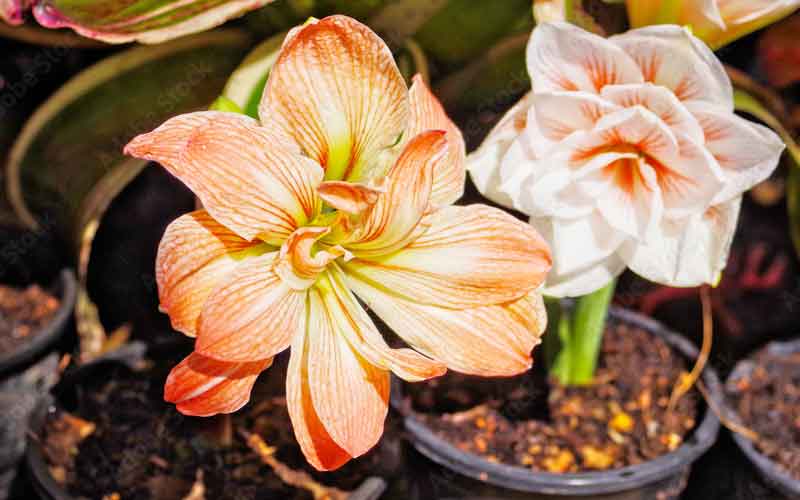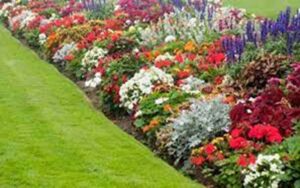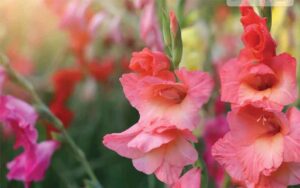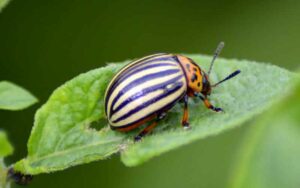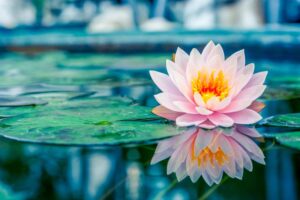Beautiful Bulbous Ornamental Plants for Your Garden
Dr. Amar Singh
INTRODUCTION
The specialized underground modified plant organ in which the food material is stored for use in future and also to overcome the unfavourable season is called the bulb. A bulb consists of a greatly reduced stem called a basal plate, surrounded by flesh-modified leaves called the scales. Botanically, this bulb may be of different types like i). Bulb-Tuberose, Amaryllis, Eucharis, etc.; ii). Corm – Gladiolus, iii). Rhizome- Iris, canna etc. and iv). Tuber- Dahlia. The plants that are produced from all the above four types of bulbous organs are commonly called bulbous plants. Different types of bulbous plants are found to grow throughout the country. They can be divided into two main categories. They are hardy and tender types. The hardy type can be grown with less care and management and can be left in the ground for a few years. The plants are then lifted after three years of planting and then separated for further planting. Amaryllis, Tuberose, Canna, Crinum, Zephyranthes etc. are the hardy type of bulbous ornamental plants. On the other hand, the tender type is that which cannot be left in the ground after flowering but is lifted from the ground on maturity. After lifting the underground bulbs are treated with fungicides to control the attack of diseases and they are then stored in cold storage or cool places during the off-season for next year’s planting. Tender types of bulbous ornamental plants are Gladiolus, Narcissus, Dahlia, etc. A bulbous plant has three distinct phases in its life cycle during a year. These stages are growth, flowering and dormancy respectively. The vegetative growth stage starts with the sprouting of bulbs. The plant develops shoot with the emergence and development of the leaves. The plants store their food in the underground bulbs which gradually increase in size. After completion of the vegetative growth the plants start flowering (as in gladiolus) or flowering starts before the emergence of the leaves (as in Amaryllis, Football-lily, etc.). After completion of vegetative growths and flowering the plants usually enter into dormancy or rest period. However, the duration of the rest period varies with the type of plants and environmental conditions like light, temperature and humidity.
IMPORTANCE AND USES OF BULBOUS ORNAMENTAL PLANTS
Bulbous plants are specially grown for their attractive flowers and foliage. These flowers and foliage have their ornamental value. Most of the bulbous plants are grown under a wide variety of soil and climate conditions. Bulbous plants can be grown in the gardens to brighten up every nook and corner of the garden with their pleasing colour. They are also suitable for window and roof gardening. Many of the bulbous plants are capable of imparting colour and warmth when they are planted under the shade of trees, at the foot of a wall, in parks and rockery and also in marshy areas. Plants like lotus and water lily can be successfully grown in the lily pool, which is an important feature of the water garden. Bulbous plants are often found to grow in the Moghal garden at Shalimar, Nishat and Chasmishahi in Kashmir. The lotus flower has a very special position in the Hindu religion. Lotus is a national flower of India. It has become a symbol of purity in the Buddhist temple. The flower is held so sacredly in Japan that it is never used during ceremonies other than Buddhist services. To the Bengalese, it is a must for Durga Puja. Bulbous plants can easily be grown as pot-plant. Potted plants can be used for different purposes. It can be kept well on the lawns and along the roads of the gardens, verandah, roof, balcony and also inside the room for indoor decoration. Pot-grown plants are also used for the decoration of conference halls, stages, meeting places, etc. Dahlia, Tuberose, Gerbera, Amaryllis, Gladiolus, etc. may be good pot-plants. Most of the bulbous plants burst into glory once in a year either by producing handsome flowers or attractive foliage. During this time they are the loveliest objects of adoration in beds, pots or clumps.
CULTIVATION
Bulbs prefer loam or sandy loam soil. In stiff clay, rooting is delayed and too much moisture often causes rotting. If the soil is not perfectly well-drained, the bulbs may be planted on a bed of sand. Watering is not required after planting as the fleshy underground stems contain sufficient food materials to develop the initial growth of roots and shoot. Before root formation, watering proves injurious to the bulbs and helps in rotting.
Bulbs, corms, tubers and rhizomes are used for vegetative propagation. Various methods and structures used for propagation are as follows.
• Division of clump—Rhizomatous plants the Canna, Alpinia can be divided into small clumps.
• Offsets produced laterally are separated for multiplication.
• Cormlets or bulblets produce new plants.
• Scales of Lilium are separated and used for propagation.
• Pieces of bulb disc with leaves or rhizome also develop a new plan
• Bulbil arising from the axils of leaves can produce new plants.
Bulbous plants are grown in beds, shrubbery, herbaceous border, grassy land and pots and bowl. Bulbs, corms, rhizomes or tubers are usually planted when they have shown signs of sprouting after dormancy.
The planting materials are normally placed deep in the soil and the soil around it is gently pressed. The depth of planting varies with the type of plants and size of bulbs. For most of the bulbous plants grown in a tropical garden, the planting depth is between 3-10 cm.
Most of these plants are sunny situations, while Eucharis and Zephyranthes thrive better in semi-shade; few types, e.g. Pancratium, Haemanthus, and Zephyranthes grow and flower well in sun and semi-shade. Bulbs, corms and tubers should not come in direct contact with fresh organic manure, rhizomes are not usually affected. The time of planting depends on the season of flowering, environmental condition of the region and condition of the planting material. In the plains, Gladiolus is planted from September to November, whereas in the hills, the planting season is normally from April-June. Amaryllis, Hippeastrum, and Haemanthus are planted in January-February to obtain flowers in March-April. Caladium and Canna are put in the ground in May.
After the above-ground portion dries out the bulbs are lifted out carefully. The root and shoot are cut and the bulbs are cleaned before storage. They should be stored in a dark, dry and airy place until the time of the next planting. Storage condition is very important for obtaining healthy bulbs. If the humidity is very high, the fungus develops on the bulbs and causes rotting. In a very dry atmosphere, the bulbs shrive and may lose viability.
It is not necessary to lift all types of bulbous plants every year. Amaryllis, tuberose, Caladium, Pancratium, and Zephyranthes may remain in the ground for three years before they are lifted. But water should be withheld when the bulbs are lying in a dormant condition in the ground or pot. Gladiolus, on the other hand, has to be lifted out every year after drying of leaves. Mentioned below are describing brief information for important ornamental plants
1. Amaryllis (Star lily)

Amaryllis bulbs are easy enough to grow indoors, and just as easy to grow in the garden, provided you live in a suitable region. They make great specimens outdoors. They perform well in beds, borders or containers outside. You can also scatter them throughout the landscape in naturalized areas.
2. Begonia (Tuberous)
Tuberous begonias prefer the filtered light beneath high trees or at least 4 hours of the morning sun. If you are planting your begonias in a garden bed, make sure to choose a spot with the right amount of light and well-drained soil. If you are growing them in pots, use high quality, humus-rich growing mix.

3. Caladium
Place the plants in a warm, dry location for at least a couple of weeks to dry out. Then cut off the foliage, place the tubers in a netted bag or box, and cover in dry peat moss. Store the tubers in a cool, dry location. Once spring returns, you can replant outdoors.

4. Canna species
They like plenty of heat, so place them in full sun. They can also tolerate partial shade. Cannas like moist conditions too, but will tolerate nearly any well-draining soil that is either neutral or slightly acidic. They appreciate bog-like conditions as well.

5. Crinum asiaticum (Cape lily)
Plant your crinum bulbs up to their necks, the slender part of the bulb, in partial shade for best results. While they prefer part shade, crinums will grow just about anywhere. They are equally at home in dry sandy soils and on moist pond banks

6. Eucharis Qrandiflora (Amazon lily)
The easy-to-grow Amazon lily bulbs can be bought in the fall. You can start with 4-5 bulbs in a six to eight-inch container since they bloom best when crowded. Just remember to plant them with their necks slightly above the soil surface. Ensure that the soil is loose and well-drained.

Eucharis Qrandiflora (Amazon lily)
7. Gladiolus
Gladiolus grow and flower best in full sun and like well-drained, sandy loam soil. For space gladiolus corms are 6 to 10 inches apart in the garden and plant corms are 2 to 6 inches deep depending upon the size of the corm (plant bigger corms deeper).

8. Gloriosa superb (Glory lily)
Grow gloriosa lily in full sun on the ground or in containers. Plant the tubers in rich, well-drained soil after the last frost (or start indoors earlier and move outside after the last frost), placing them carefully (they are quite brittle) in a horizontal position, 2-4 inches deep.

9. Hymenocallis littoralis (Spider lily)
Fall or early spring is the best time to plant spider lily bulbs. You’ll get the most flowers if you plant them in full sun to partial shade. Spider lilies like rich, moist but well-drained, slightly alkaline soil that dries out between rains.

10. Polianthos tuberose (Rajani gandha)
Rajanigandha is grown from its bulbs during the spring season when the temperature is not so low. This plant belongs to hotter parts of the world and prefers a temperature range above 15°C. It can be grown in soil or pots.

11. Sinninqia speciosa (Gloxinia)
It is native to Brazil. Gloxinias are among the best plants that are grown for spring and summer enjoyment, although with proper handling, flowering plants can be produced throughout the year. Their velvety, bell-shaped flowers can average over 3 inches in diameter.

12. Zantedeschia aethiopica (Arum lily)
Although an outdoor plant by nature, the Calla Lily will perform wonderfully as an indoor plant. Keeping this rhizome happy indoors is a matter of paying attention to some very basic growing conditions. The Zantedeschia aethiopica is native to southern Africa.

13. Hemerocallis (Liliaceae)
Hemerocallis should be planted in full sun or partial shade that receives 4-6 hours of sun per day. Despite the preference for full sun, occasionally colourful daylily blooms can be found under the shade of tall trees. Wherever some shade is present, the daylily flowers will face away from it toward the open sky.

Hemerocallis (Liliaceae)
14. Tulip (Genus tulipa)
Pick a spot in your garden that has well-draining soil and gets full sun or partial shade. Plant the tulip bulbs about 5-7” deep and 4-5” apart, placing them in the ground with their pointy ends up. Water well once and wait for spring. After the tulips have bloomed don’t cut off the foliage

Tulip (Genus tulipa)
15. Daffodils
To enjoy the daffodils at the end of the winter or early spring bulbs should be planted in autumn (September-November). This plant does well in ordinary soil but rather flourishes best in rich soil. She likes the sun but also accepts partial shade exposure

16. Iris (Iris germanica)
Growing irises from bulbs are easy and provide some of the earliest blooms in the garden; later-flowering varieties compliment summer-flowering plants. Whether in containers or the open garden, they are hardy and provide colour year after year.

Iris (Iris germanica)
17. Easter Lily (Iilium longiflorum)
Light Requirements. Potted Easter Lilies grown indoors will need bright, indirect natural daylight; direct, bright sunlight can cause burning issues. Potted Easter lilies (Lilium longiflorum) can be planted in the garden after all danger of frost; this should be done after the flowers have withered away.

Easter Lily (Iilium longiflorum)
18. Crocus (Crocus sativus)
Saffron Crocus (Crocus sativus) create quick jewel-toned flowers in the fall garden in about 6-10 weeks (sometimes as little as 4-6 weeks) after being planted. They can be planted in the garden in zones 6-10 or can be used in containers on a patio or grown indoors.

Crocus (Crocus sativus)
19. Lotus flower (Nelumbo nucifera)
Tubers should be planted about 3 cm deep in soil that is below 60 cm to 1.4 m of still water (or plant water lily tubers in a container, and sink the container). When growing water lilies from seed the easiest way is to roll the seed in a ball of clay and drop it into a pond that is of the required depth.

Lotus flower (Nelumbo nucifera)
20. Dahlia (Dahlia pinnata)
Dahlias like a sheltered spot, with as much sun as possible – a south or west-facing border is ideal. Dahlias are not fussy when it comes to soil. For best results grow in any fertile, moist but well-drained soil. Enrich the soil with some organic matter, such as well-rotted manure.
Dahlias are easy plants to grow and yield beautiful blooms from mid-summer through fall. In many respects, “dahlia culture” is similar to “tomato culture.” If you can grow tomatoes in your garden, you can successfully grow dahlias.

Dahlia (Dahlia pinnata)











